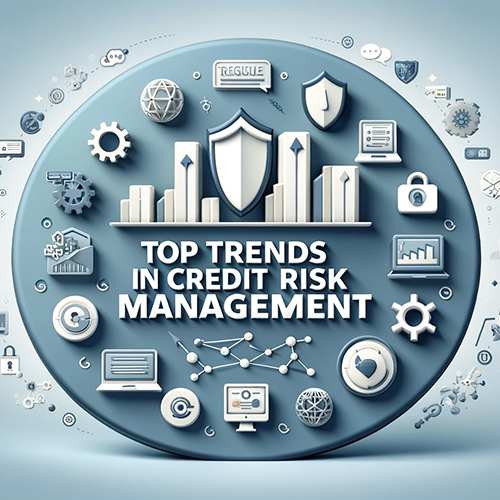Credit risk management is essential for financial institutions to identify, assess, and mitigate lending risks. This blog explores the latest trends in credit risk management, including advanced data analytics, AI automation, enhanced cybersecurity, bias elimination, improved customer experiences, addressing non-financial risks, and navigating regulatory changes. These trends help institutions manage credit risk more effectively, ensure compliance, and maintain competitiveness.
Credit risk management is one of the fundamental processes and an essential function in financial institutions. It aims to identify, assess, and reduce or mitigate the potential risks of lending money to borrowers, such as individuals, businesses, or other entities.
Credit risk management involves evaluation of the likelihood of a borrower failing to repay their loans and taking appropriate actions to minimize the impact of those risks on the lending institution.
The strategies and tools for credit risk management continue to evolve with the changing financial landscape. The following are some of the top trends in credit risk management and insights into the latest developments and their implications for financial services.
1. Harnessing Advanced Data Analytics and Real-Time Data Integration
One of the most significant trends in credit risk management is the increased use of data analytics along with real-time data integration. Financial institutions are leveraging big data and machine learning approaches to improve their credit risk assessments.
Approx. 78% of financial institutions have increased their investment in data analytics to improve risk assessment and management.
Also, 63% of banks are leveraging real-time data integration to improve decision-making and mitigate credit risk.
Machine learning and real-time data enable more accurate predictions and enhance business decision-making as follows:
- Machine Learning Models
Machine learning models are considered more accurate than any other traditional statistical model by 10-15% when measuring the risks. These models learn from new data continuously and predict each time with more accuracy. - Real-Time Data
Creditworthiness is assessed based on real-time integration of data several sources, including transaction histories, social media, etc. Real-time analysis helps lenders adjust credit limits quickly and identify the warning signs of defaults.
Explore how predictive modeling and next-best-offer analytics are helping institutions act proactively in credit decisioning.
2. Leveraging Automation with Artificial Intelligence
Automation and artificial intelligence are changing credit risk management by improving operational efficiency and reducing human errors.
AI-based tools can handle vast amounts of data and provide insights that human analysts may miss. Some of the applications are:
- Automated Underwriting
Artificial intelligence systems can automate the process of underwriting. It makes the process faster and more efficient. This also helps reduce operational costs and enables banks to process more applications faster.
An estimated 47% of credit risk professionals report significant efficiency improvements due to AI and machine learning in reducing manual processes.
- Fraud Detection
Artificial intelligence can check and detect fraudulent activities by analyzing patterns and anomalies in transaction data. This proactive approach helps prevent losses.
Approx. 58% of banks plan to boost their AI investments in the next two years to manage credit risks more effectively.
3. Fortifying Cybersecurity Measures
As more banking and financial activities adopt digital solutions, cybersecurity has become an integral part of their credit risk management mandates. Financial institutions are investing heavily in cybersecurity to protect sensitive data and maintain customer trust.
- Security Investments Globally
It is said that the global security services revenue is expected to touch $9.8 billion by 2024. This highlights and reflects the importance of cybersecurity in the financial sector.
- Preventative Measures
These enhanced measures involve flagging suspicious transactions or activities and compliance with strict regulations for data protection. Preventative measures preempt data breach and financial and reputational losses due to cyberattacks.
4. Eliminating Bias in Credit Risk Decisions
Removing biases from credit risk assessments is crucial to making better and more accurate decisions. Today, financial institutions are significantly working on reducing biases so that they can evaluate credit applications objectively.
- Bias Identification and Mitigation
Some of the techniques employed by financial institutions to identify and reduce bias in credit risk decisions include analytical measures, debating strategies, and organizational changes.
About 35% of credit decisions exhibit some level of bias, prompting a focus on bias elimination through advanced algorithms and AI.
- Regulatory Compliance
Ensuring AI-driven models are explainable and free from biases is essential for regulatory compliance. It also requires maintaining ethical standards in lending practices.
Financial institutions using AI for credit decisions have reduced bias by 29% compared to those using traditional methods.
5. Enhancing Customer Experience with Digital Solutions
Context-relevant digital solutions can augment customer experience and streamline credit risk management process. More financial institutions are adopting these digital-first strategies to meet the evolving expectations of tech-savvy consumers.
- Digital Onboarding
Digital platforms digitize and streamline the onboarding process, reducing customer drop-off rates and enhancing customer satisfaction.
Reportedly, 82% of customers prefer digital interactions for credit applications and inquiries.
- Omnichannel Approaches
Connecting customers across various platforms ensures a seamless and efficient service experience, increasing loyalty and retention.
An estimated 70% of banks report that digital transformation initiatives have improved customer experience and satisfaction.
6. Addressing Non-Financial Risks
Non-financial risks, such as cyberattacks and operational risks, have already started playing an increased role in credit risk management. Financial institutions are developing wide-ranging strategies to stay abreast of these new risks.
Approx. 55% of financial institutions are integrating non-financial risks, such as environmental and social risks, into their credit risk assessments.
- Cybersecurity Focus
Given the increasing threats of cyber-attacks, financial companies need to prioritize the right measures to ensure cybersecurity to protect the operations and data of customers.
Financial institutions face an average of 85 serious cyberattacks annually, underscoring the critical need for robust cybersecurity measures.
- Operational Efficiency
Financial institutions need to ease their processes and eliminate operational costs without compromising their risk management capabilities.
For practical strategies, explore how managed services and digital transformation are enabling banks to enhance resilience while controlling costs.
7. Navigating Regulatory Changes and Compliance
Financial institutions must stay abreast of the ever-changing global regulatory requirements, rules, and guidelines and calibrate their policies and efforts to address emerging risks.
Key imperatives include:
- Global Compliance
Financial institutions must adapt to navigate the complex regulatory environments locally and internationally. They need to ensure compliance with all laws and regulations, including cross-border compliance.
An estimated 68% of banks have implemented new compliance technologies to keep up with evolving regulations.
- Adaptation to New Regulations
It will be essential to adapt in advance to new regulations, be it for the crypto industry or environmental sustainability, to remain compliant and avoid penalties.
Conclusion
Risks due to cyberattacks, AI-related issues, climate change, rising interest rates, evolving regulations, and geopolitical instabilities pose bigger challenges for financial institutions.
Emerging trends in credit risk management reflect a shift towards subtler and technology-driven approaches to counter these risks. For instance, advanced analytics with automation, AI, and cybersecurity will enable financial institutions to manage credit risk more effectively and enhance decision-making capabilities.
Also, get insights from our blog on Effective Risk Management Techniques to Improve Credit Portfolio Returns to align your credit strategy with portfolio performance goals.
Additionally, focusing on eliminating biases, enhancing customer experience, and staying compliant with regulatory changes are critical for maintaining market competitiveness.
To learn how to upgrade your risk strategies, reach us at info@anaptyss.com












